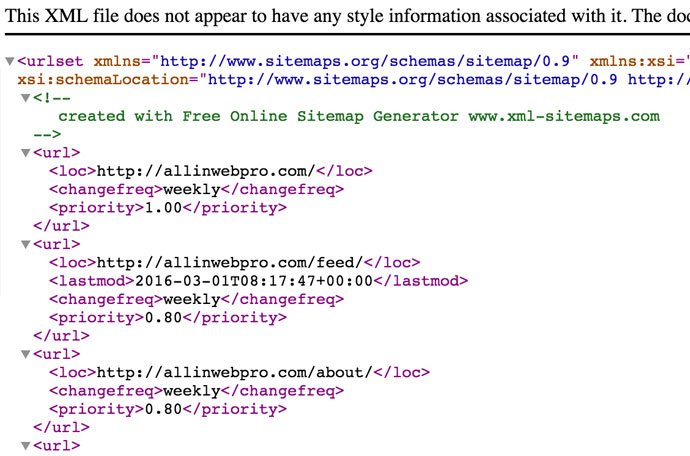Google Ranking
How Responsive Web Design Can Benefit Your Business
What is Responsive Web Design
Responsive web design is more than just the latest trend in web design. If you live in the digital world, you’ve probably already heard of it and may have seen it used on many of your favorite websites in the last few years. If you haven’t, responsive web design is the approach to designing websites in which the content automatically self-adjusts to your screen or device size for optimal view.
This allows the website to adapt its contents to your screen or device, positioning the content in the best possible way, changing the size, shape, and relationship between the various elements on a webpage. Responsive web design is also sometimes referred to as “mobile-friendly”, or “mobile-ready” web design. There are a variety of ways for a website to be responsive from a technical coding perspective, but the end result is that you the webpage you look at will change as you adjust the width of your web browser screen either by changing the orientation of your mobile device from horizontal to vertical, or by dragging the edge of your desktop browser sideways to make your browser window more narrow horizontally. (Hint: Try it with this webpage and see if you can find everything that changes.)
Before Responsive Design
In the past, businesses would need to hire a designer to make different versions of their website if they wanted it to be usable on mobile devices. These would usually include a version for desktop users, mobile phones and maybe even a tablet version. However, with a growing plethora of devices users were able to browse the internet on, this quickly became a difficult strategy to implement. With responsive design, you have only a single website that automatically adjusts its contents and layout to fit whatever screen size or “viewport” it’s being viewed on.
How Can Responsive Design Help Me?
Now that we understand what responsive design is, the next question might be how can responsive design benefit your business? One of the biggest ways responsive web design can benefit your business is improving your ability to reach the large audience of mobile device users in search engines. Over 80% of adults in the United States own a smartphone with internet access, and reports show that mobile devices accounted for over 60% of website traffic in 2014. The mobile device market is growing every day and as more people adopt these devices we will only see these numbers grow.
Responsive Design Improves User Experience
If you sell businesses products or services online, you should be concerned about how you can increase your sales or increase the conversion rates of your website. Responsive web design will also make your website look better, be more user-friendly across different devices and provide a consistent user experience. In turn, this will help drive sales and have a positive impact on your conversion rates. In short, having a responsive web design can actually help you sell more of your products or services and make more money as well as make your website easier to use.
Google Demotes Non-Mobile-Friendly Websites
Google also has stated that they are going to begin demoting websites that are not deemed “mobile-friendly” in its search results for people searching on mobile devices. You can test whether your website is “mobile-friendly” according to Google by visiting Google’s Mobile Friendly Test page and submitting your website address there.
Streamlining Web Design Updates and Maintenance
Another important benefit of responsive design is that it can actually save you time and money. Designing a responsive website is faster than creating separate stand-alone websites for mobile viewing and will save you money when it comes to your development, support and maintenance overhead over time. The good news is that most website themes built today are responsive by default, and is now considered the norm in website development.
About All in Web Pro
All in Web Pro is a leading Las Vegas’ web design company. We understand that your business depends on staying connected to your clients, and we’ll ensure that you’re delivered a professionally designed website that will engage your audience, showcase the best you have to offer, and deliver results for years to come.
How Mobilegeddon Affects Your Website & Business
What is Mobilegeddon?
Google’s new mobile update, dubbed “Mobilegeddon” by internet marketers, has far-reaching implications for both your website’s SEO (search engine optimization) and your business. Mobilegeddon’s affects, which began in April of 2015, had a negative impact on the search result rankings of websites that are not mobile-friendly. However, for the long term, Google is making a clear statement that mobile devices and mobile search are becoming a critically important aspect of digital commerce and internet use in general.
Mobile Use is Sky-Rocketing
In the last few years, mobile device and tablet use has been skyrocketing to record numbers year over year. In 2014, statistics showed that the use of non-desktop devices, such as tablets and mobile phones, outnumber PC’s online. Although mobile devices have not yet surpassed desktops in the amount of searches on Google, smartphones are quickly approaching desktops in search. These days, nearly 90% of purchases for local goods and services are first researched online through search engines and more than 70% of business traffic is driven by search.
Search is extremely important and valuable to businesses, and trends are moving towards mobile search as the primary digital mode of the future as more people use their phones and tablets to search for products, solutions, content and more. Consider how many times you’ve used your iPhone or Android device to search for a local restaurant or business in your city, or perhaps while you were in a store and searched for reviews or prices of a product you were thinking about buying.
Google is Constantly Updating
Google is highly aware of these trends and is constantly testing and analyzing user behavior to deliver higher quality results and a more user-friendly experience to Google searchers. They are always looking for ways to connect users with the most relevant search results possible while also providing a improved user experience across all devices.
Responsive & Mobile-Friendly Web Design
Responsive web design refers to websites that respond dynamically to the size of the web browser that they are displayed in. Websites that are responsive can change in a variety of ways by adjusting their visual elements including font, images, layout positioning, and relationships between elements in different ways on the fly without requiring the web browser to be refreshed. This can be easily be observed by adjusting the width of the browser window you are viewing. Common elemental changes in a website that is responsive include the morphing of menus into a button with 3 horizontal lines, the vertical stacking of images and layout elements that were previously in rows, and the adjustment or removal of large elements in order for them to still fit on the webpage.
Responsive Web Designers
All in Web Pro is a leader in Las Vegas web design, graphic design, and custom web development that is focused on building mobile-friendly websites & web applications. We can update your website to make sure it is Mobilegeddon compatible so that your search engine rankings and business achieve the best results possible. Our web design services utilize responsive web designs that are mobile-friendly and will optimize your website across any mobile device and browser viewport on phone or tablet.
As the web has evolved, so has All in Web Pro. Our role in helping businesses increase their search engine visibility and provide excellent user experiences to their customers through the most modern web design practices, has helped make Las Vegas based All in Web Pro a leading provider of web design, graphic design, and online brand consulting & marketing.
How to Update your Sitemap.xml file for Google and Bing
Your Sitemap.xml file might not be up to date
Recently I've become inspired to create a multitude of new pages and blog posts for our All in Web Pro website to add a wealth of new content to our site to bring helpful information to our clients and site visitors, as well as to boost our ranking in Google searches. This week after publishing several new blog posts in a row I wanted to double check our sitemap.xml file to make sure Google & Bing had the most up to date list of all of our old and new webpages.
We'd been using a WordPress plugin called "Google XML Sitemaps" which had worked for us in the past and is designed to automatically update the sitemap.xml file anytime a page or post is created or updated on your WordPress website. This is important because you want all of your new webpages to be announced to search engines as soon as they're live on your website. And although search engines automatically rescan your website to look for new content and pages, submitting it to them directly can speed up the process and help those pages get indexed and seen by search engine users faster.
So after checking our sitemap.xml file that the Google XML Sitemaps plugin was generating, I noticed the blog posts I'd submitted a week earlier weren't appearing. I'm going to update our WordPress core and activate the plugin to see if it will start working again. But in the meantime I needed a way to update our sitemap quickly and manually to make sure it's appearing correctly with all of our links. Which is where the following short tutorial on how to update your sitemap.xml file begins.
What is a sitemap.xml file?
A sitemap.xml file that sits on your website's hosting server which tells search engines all of the pages on your website that exist, what priority you rank the pages in, when they were last updated, and how frequently you update them. This information helps Google & Bing know how often to rescan your website's pages for updates and which pages on your site are more important to show in search results. It's also a good way to announce the creation of new pages on your site to Google & Bing. The file is written in XML, which is similar but different from HTML, another type of "Markup Language, which is what the "ML" are abbreviations for. So it's important that your XML file is created correctly with no errors in the XML format.
Why is my sitemap.xml file so important?
If you want to have the best chance of showing up on the first page of a Google or Bing search when your potential customers or audience are doing relevant searches you need Google and Bing to know all of the pages on your website, which ones are the most important ones you want appearing, and also to include your most recently created content. If your sitemap is not up to date it will tell search engines that maybe your website isn't being updated and therefore might not have the most relevant and current information on it. Many other factors are taken into consideration, but when you know sitemaps have an impact on your search rankings and are an important part of SEO, why not be safe and make sure it's correct?!
5 Steps to Updating your sitemap.xml file
Here's a quick list of steps you can take to manually update your sitemap.xml file. Once finished you'll know it's live by simply go to your website homepage and add '/sitemap.xml' after '.com' or '.net'. (e.g. www.domain.com/sitemap.xml)
1. Generate your XML Sitemap file
There are several websites you can visit to generate a sitemap file for your website. I did a Google search for "sitemap generator" and found XML-Sitemap.com which worked well. Just enter your website URL and download the free files generated. The file we need is sitemap.xml.

2. Upload your sitemap.xml file to your website's root server
To get your sitemap.xml file onto your website's hosting server you'll need one of the following 2 things. A) The login & password to the hosting control panel for your website so you can utilize a file manager tool that your web hosts provides to upload the sitemap.xml file to your website's root (/) folder. B) You can download a free FTP (file transfer protocol) program to your computer, such as FileZilla, which will enable you to upload files directly to your website's hosting server. You'll still need to have an FTP user account created on your hosting account, which will have a username & password along with a hostname. For hostname you can usually just type your website domain name (e.g. allinwebpro.com), otherwise you can use the IP address of the web host server where your website's files are located, which your hosting company provides you.
3. Make sure sitemap.xml is in your server's root folder
The sitemap.xml file should be uploaded to the root folder of your website. This is usually the folder labeled '/', and is also usually the same folder where you'll find usually also see the 'index.php' and '.htaccess' files.

4. Verify your sitemap.xml file is live
Now go to your website and add the '/sitemap.xml' suffix to your website's domain name, like this: 'www.mydomain.com/sitemap.xml'. If the page you see looks something like this then it worked!
5. Submit your new sitemap to Google & Bing
Both Google and Bing have an advanced Webmaster Tools service where you can create an account and manage all of the different websites that you administrate. You'll need to verify that you control your website by following their verification instructions, which usually involves adding a snippet of code to the header or footer of your homepage. Once verified you can navigate to the 'sitemap' area of Webmaster Tools to submit or resubmit your sitemap.xml file. Both search engines have advanced tutorials and help information to help you complete this task, and both provide advanced reporting tools to let you know more about your website including any broken links, or how many pages are currently indexed vs what was submitted.
Other Options
Although this method works, it is a little time consuming and it would be much easier to simply upload a plugin to your WordPress dashboard that would automatically update your sitemap.xml file anytime changes were made to your site. I'm going to do some plugin tests and see if any are reliable and will update this blog post accordingly. But it's helpful to know how to manually create your own sitemap.xml file in the event that plugins become buggy or aren't picking up all of the links to your site, especially if you start using a subdomain which may be tricky for some automated plugins to read.
What Sitemap Tools Do You Use?
Please comment below if you found this sitemap.xml guide helpful, or if you have other websites, plugins, or tools that worked well for you.
About All in Web Pro
All in Web Pro is a Las Vegas Web & Graphic Design company that has been helping small and medium sized businesses unlock the power of the internet to accelerate their brands since 2010. If need help with your website or have want to know how to get more value out of your website, call our team today! 702-331-0650
6 Simple SEO Habits to Increase Website Rankings & Traffic
In our Digital Age, the success of your business depends on getting noticed online. With 83% of U.S. consumers researching online before they make purchases, and 80% of global consumers doing the same, being found on the internet is tied to your survival in your marketplace. If your customers are not clicking on your website link and coming to you when they are searching for the products or services your company provides, they are locating and interacting with your competitor.
As the numbers of consumers doing primary research on the internet before they buy continue to rise year by year, being easily accessible online will only become more crucial. Being among the first search results in your category is the only way to guarantee consumers interested in what you do and what you sell will be able to discover your company. In fact, on any Google search page in organic results the #1 ranked link gets 33% of clicks, the #2 receives 22%, the #3 grabs 11%, #4 nabs 7%, on down until #10 only catches 1-3% of clicks. The conclusion is strikingly apparent—your website must live on the prime real estate of the top of the Google page or you will drown into the oblivion.
Why is SEO imperative to the success of your business? Because if you want to be around in 5 years you have to stand out from your competition so consumers find you, and not them. But fear not, there are easy methods to boost you to the top of the search rankings for those keywords that represent the services you provide and products you sell.
6 SEO Tips And Habits for Ranking High in Search Engines:
1. Check rankings weekly.
 You need to know where you rank, and checking your SERP for your top 10 keywords is a great way to know exactly how you stack up against the competition. SERP is an important acronym to know if you’re doing any online marketing campaign. "SERP" is short for "search engine results page", and since marketing through search is a dominant factor in online marketing, you need to be aware of how you measure up to your competitors, and not for just one keyword, but for all of them. This will tell you where you stand and allow you to gauge how well each SEO strategy you implement works. Getting easy to access measurable feedback will help you see what’s working well over time and what isn’t. We recommend using micrositemasters.com to easily track the ranking of your top 10 keywords for free. We can also provide and manage this for you if needed.
You need to know where you rank, and checking your SERP for your top 10 keywords is a great way to know exactly how you stack up against the competition. SERP is an important acronym to know if you’re doing any online marketing campaign. "SERP" is short for "search engine results page", and since marketing through search is a dominant factor in online marketing, you need to be aware of how you measure up to your competitors, and not for just one keyword, but for all of them. This will tell you where you stand and allow you to gauge how well each SEO strategy you implement works. Getting easy to access measurable feedback will help you see what’s working well over time and what isn’t. We recommend using micrositemasters.com to easily track the ranking of your top 10 keywords for free. We can also provide and manage this for you if needed.
2. Leave your link.
Create a digital trail by linking to your website everywhere you go: in profile pages, social media interactions, blog comments, articles, friends' websites, your competitors sites, social networks, and any other websites that show up in relevant Google searches. Don’t forget to ask others to link to you (especially if you guest blog or participate in a speaking engagement, panel, seminar or other industry event). Always be genuine and don’t be a “sales person”.
3. Update old content.
Update the content on your web pages annually and be sure to remove or change any content that is outdated or incorrect. By recycling older, popular blog posts you can get extra mileage out of them. If industry updates and changes have occurred, you can create a new blog post by piggybacking off the original article. Also, keep your web content current so consumers are confident you are a leader with your finger on the pulse of your market.
4. Build more unique content.
Have little to no original text content on your webpages will hurt your ranking in Google. If you say the same thing over and over, even if you change some wording and sentence organization, search engines will also identify it as not adding new value and may penalize you for it too. Conversely, the more original and unique content you have that brings new value to your visitors, the higher you will rank on relevant search engine results pages. The more new original content you have, the better.
5. Ask for reviews.
Regardless of what type of website or business you have there are websites where people can write reviews about you. Take advantage of the opportunity to let your best customers and fans write something nice about you on those websites. If you're a restaurant Yelp is an obvious place for this. Any location based website can ask their clients to write reviews for them on their Google Places page. It's easy to ask, and there's a special kind of emotional reward that only comes from being asked to "give" something nice to a company or brand you love. You'll be surprised how many people will do this for you, IF you ask.
6. Create a weekly goal, make a plan, & follow-through
Even if your competition knows all of the best SEO techniques, none of it matters unless you take the time to put it into practice. Setting a long-term and achievable goal might just be the most powerful tool in your SEO arsenal.
Set a Weekly Goal; make sure your weekly goal is easy to achieve, don't shoot for the moon. The hardest step is the first one, so make sure it's easy for you to accomplish your weekly goal in a short amount of time and that you have easy ways to measure the progress you're making.
Develop a Plan; great goals are nothing without a solid plan for how to execute them. Be sure to plan exactly how you'll have time to achieve your weekly goal and to be patient with yourself and don't expect perfection on the first try. The more you do it the better you'll get.
Follow-through; create an incentive and accountability system for yourself. Put reminders up where you will see them, and set consequences that help ensure that if you do skip a goal, that you can easily catch up and get back on track. If it means skipping a Friday night out, so be it, your business and brand is worth it, and once you make a sacrifice, you'll be less likely to skip your goal from that point on. Or tell your colleagues and friends that you're setting a goal and want them to hold you to it, make them a bet and get others involved.
Closing Thoughts.
At the heart of SEO there is a search engine trying its best to analyze webpages and bring the public the most relevant and valuable information according to each and every unique search that's performed. And if you use these tips wisely and develop them into habits that you put into practice on a consistent basis, you'll be guaranteed to start noticing significant and consistent improvements in your search engine rankings that will stand the test of time and make these search engine happy. And it goes without saying that you should always keep the need and experience of your end user in mind because ultimately the quality of their experience on your website will determine your future.
SEO can be complicated and overwhelming at times, and we recommend consulting a trained professional before starting any SEO campaign. If you need help implementing any of these techniques into your online strategy please contact us for a free SEO consultation and we'll be happy to assist you.




